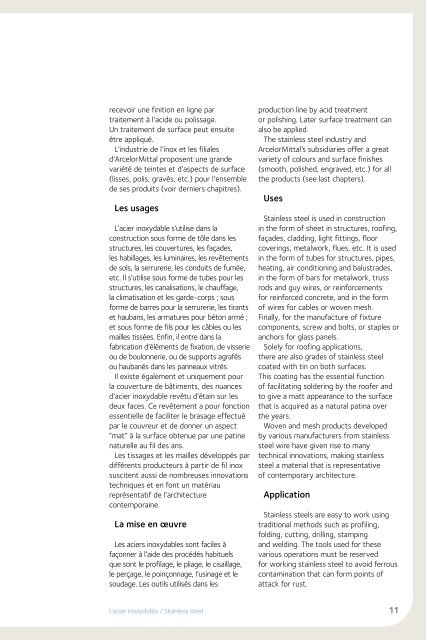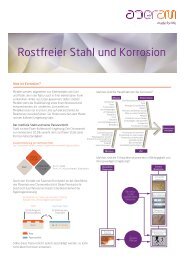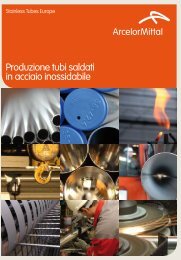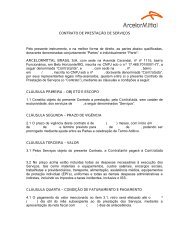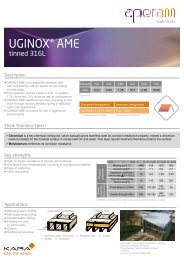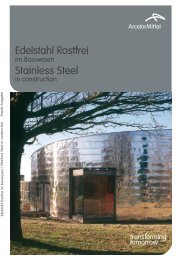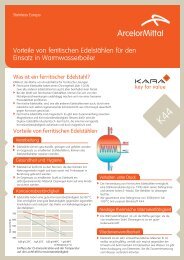Stainless Steel L'acier inoxydable - Aperam
Stainless Steel L'acier inoxydable - Aperam
Stainless Steel L'acier inoxydable - Aperam
You also want an ePaper? Increase the reach of your titles
YUMPU automatically turns print PDFs into web optimized ePapers that Google loves.
ecevoir une finition en ligne par<br />
traitement à l’acide ou polissage.<br />
Un traitement de surface peut ensuite<br />
être appliqué.<br />
L’industrie de l’inox et les filiales<br />
d’ArcelorMittal proposent une grande<br />
variété de teintes et d’aspects de surface<br />
(lisses, polis, gravés, etc.) pour l’ensemble<br />
de ses produits (voir derniers chapitres).<br />
Les usages<br />
L’acier <strong>inoxydable</strong> s’utilise dans la<br />
construction sous forme de tôle dans les<br />
structures, les couvertures, les façades,<br />
les habillages, les luminaires, les revêtements<br />
de sols, la serrurerie, les conduits de fumée,<br />
etc. Il s’utilise sous forme de tubes pour les<br />
structures, les canalisations, le chauffage,<br />
la climatisation et les garde-corps ; sous<br />
forme de barres pour la serrurerie, les tirants<br />
et haubans, les armatures pour béton armé ;<br />
et sous forme de fils pour les câbles ou les<br />
mailles tissées. Enfin, il entre dans la<br />
fabrication d’éléments de fixation, de visserie<br />
ou de boulonnerie, ou de supports agrafés<br />
ou haubanés dans les panneaux vitrés.<br />
Il existe également et uniquement pour<br />
la couverture de bâtiments, des nuances<br />
d’acier <strong>inoxydable</strong> revêtu d’étain sur les<br />
deux faces. Ce revêtement a pour fonction<br />
essentielle de faciliter le brasage effectué<br />
par le couvreur et de donner un aspect<br />
“mat” à la surface obtenue par une patine<br />
naturelle au fil des ans.<br />
Les tissages et les mailles développés par<br />
différents producteurs à partir de fil inox<br />
suscitent aussi de nombreuses innovations<br />
techniques et en font un matériau<br />
représentatif de l’architecture<br />
contemporaine.<br />
La mise en œuvre<br />
Les aciers <strong>inoxydable</strong>s sont faciles à<br />
façonner à l’aide des procédés habituels<br />
que sont le profilage, le pliage, le cisaillage,<br />
le perçage, le poinçonnage, l’usinage et le<br />
soudage. Les outils utilisés dans les<br />
production line by acid treatment<br />
or polishing. Later surface treatment can<br />
also be applied.<br />
The stainless steel industry and<br />
ArcelorMittal’s subsidiaries offer a great<br />
variety of colours and surface finishes<br />
(smooth, polished, engraved, etc.) for all<br />
the products (see last chapters).<br />
Uses<br />
<strong>Stainless</strong> steel is used in construction<br />
in the form of sheet in structures, roofing,<br />
façades, cladding, light fittings, floor<br />
coverings, metalwork, flues, etc. It is used<br />
in the form of tubes for structures, pipes,<br />
heating, air conditioning and balustrades,<br />
in the form of bars for metalwork, truss<br />
rods and guy wires, or reinforcements<br />
for reinforced concrete, and in the form<br />
of wires for cables or woven mesh.<br />
Finally, for the manufacture of fixture<br />
components, screw and bolts, or staples or<br />
anchors for glass panels.<br />
Solely for roofing applications,<br />
there are also grades of stainless steel<br />
coated with tin on both surfaces.<br />
This coating has the essential function<br />
of facilitating soldering by the roofer and<br />
to give a matt appearance to the surface<br />
that is acquired as a natural patina over<br />
the years.<br />
Woven and mesh products developed<br />
by various manufacturers from stainless<br />
steel wire have given rise to many<br />
technical innovations, making stainless<br />
steel a material that is representative<br />
of contemporary architecture.<br />
Application<br />
<strong>Stainless</strong> steels are easy to work using<br />
traditional methods such as profiling,<br />
folding, cutting, drilling, stamping<br />
and welding. The tools used for these<br />
various operations must be reserved<br />
for working stainless steel to avoid ferrous<br />
contamination that can form points of<br />
attack for rust.<br />
L’acier <strong>inoxydable</strong> / <strong>Stainless</strong> steel 11


